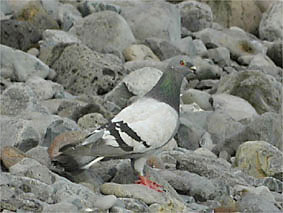

Columba livia (photographer unknown; location unknown)
Wild-type Rock Pigeon
(Pattern = bar) (Color = "blue") (Pigment = blue/black)
This phenotype is known as "blue bar"
W.F. Hollander used the term blue/black for the pigment to indicate that even though we "see" dove-gray or blue as well as black that the pigment is actually "black", i.e.,- melanin. The pigment is either "clumped" or "spread" in various parts of the bird. In the "spread" areas such as the bars, it appears black to us. In the "clumped" areas, such as the wing shield, it refracts light differently and we see it as "blue" or "dove gray". Note, especially, the species specific two wing bars and terminal tail bar as well as the albescent (whitish) strip on the outer edges of the outside tail feather. The red legs are also a species trait, as is the purple/green iridescence of the neck.
Pattern = barless; wild-type (bar); checker (chequer).
These are the only three patterns known in Columba livia. They are listed here in ascending order of dominance. Barless is extremely rare to non-existent in wild or feral populations. Checker or check has various alleles; light check, check, dark check, & T-pattern check.Pigment - There are presently only three pigments known in Columba livia. Brown, wild-type (black); and red (ash-red). These are sex-linked with brown being the least dominant. Matings of a less dominant pigmented male to a more dominant pigmented female produce all male young with the pigment of the mother and heterozygous for the pigment of the father and all female young with the pigment of the father. Such young may be immediately sexed in the nest once plumage color is ascertained. (For example: a brown cock mated to an ash-red hen will produce all brown females and all ash-red males heterozygous for brown.)
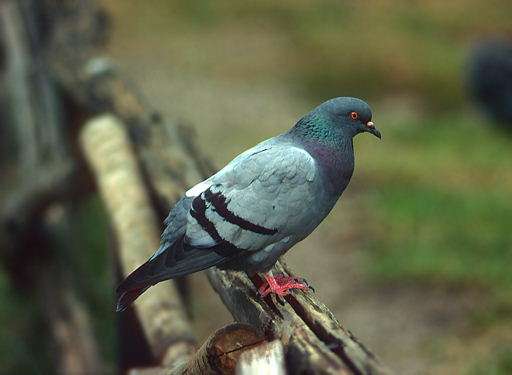
Columba livia (photographer unknown; location unknown)
(Pattern = bar) (Color = "blue") (Pigment = blue/black)
Phenotype = blue bar
In this photo, you can also see the white lower back/rump area. Recent studies indicate this may possibly (and I stress that word) be related to an anti-peregrine defense which has evolved.
Nature Vol. 434, 21 April 2005, http://www.nature.com/nature Note also the bright orange-red eye of the wild bird.
Columba livia in flight (photo copyright by Schmoker) (Colorado, U.S.A.)
(Pattern = unknown, can't tell from photo) (Color = "blue") (Pigment = blue/black)
Phenotype = unknown
Note the light underwing (axillary) feathers. If these birds carried dirty, the feathers would be much darker gray. Note the ten primary flights - counting from the outside in, they would be numbered 10-9-8, etc. with the number one primary being closer to the body. Pigeon fancier usage, then counts all the inner feathers from there as secondaries. With the secondary closest to the number 1 primary being the called the Number 1 secondary. Fanciers never use the ornithologist usage of distinguishing secondaries from tertiaries. Note also, that in the lead bird (to the right in the photo above), you can also clearly see the albescent strips on the outer edges of the outer tail feathers. One really great thing about this photo is that you can clearly see that the wing bars are actually not solid, but are composed of spots on individual feathers. Also, you can see that the trailing pigeon, to the left in the photo, is clearly looking at something on the ground - perhaps the photographer.
=======================================================
Feral pigeons, i.e., those birds which have reverted to the wild from some domestic ancestor at any point in time, may or may not look like the birds above. True ferals often approximate wild-type C. livia in body mass and type, but pattern and color are sometimes very different. Ferals may also be under under different selective pressure than are the wild-type since many ferals live in cities worldwide as well as in situations approximating that of their wild ancestors. Below, I've tried to show some of the many different patterns and colors as possible of what may be seen in ferals. I've also provided site links to pigeon pictures. Not all the birds depicted are feral, some are domestic, but each shows a pattern or color that I've seen in the wild. If you float your cursor on each picture on this site, at least, you will also see the color terminology used to describe each one.

Phenotype = Check (L); Check grizzle white flight (R)
Because of behavior shown, the bird on left appears to be a female or hen;
while that on right is definitely a male or cock bird.You will sometimes hear people describe these birds as blue check and blue grizzle white flight.

; ; (L) T-pattern checker Ferals in Melbourne Australia Light checker (chequer); [blue check]
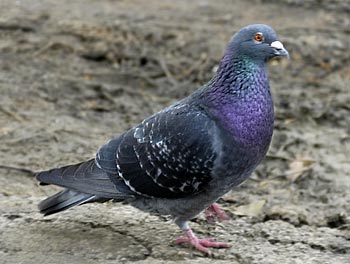
Dark check (chequer). This is a male. Note that in dark checker the base color of the wing is visible, while in T-pattern Check it is almost totally, if not totally, hidden.
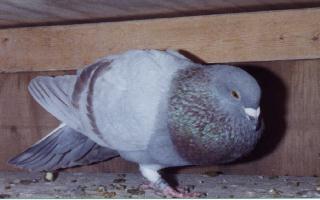
Pattern = bar; Pigment = red (ash-red)
Phenotype = Ash-red bar
This bird is a male or cock bird.
This bird, while a Racing Homer, shows another common color in ferals. Ash-red bar. Note that in the ash-reds, the terminal tail bar is washed out and almost vanishes while the wing bars are a dark, brick red color. This is a bird I bred and which is owned by a young man in Maryland now.
Ash-red dark check (Note ashy colored flights and tail. Note also that the tail bar is so light as to be almost indistinguishable.
This pigeon looks to be Sooty rather than check.
Ash-red check
T-pattern check in flight. Note the tail bar and incoming wing flight. Copyright by Mike Danzenbaker
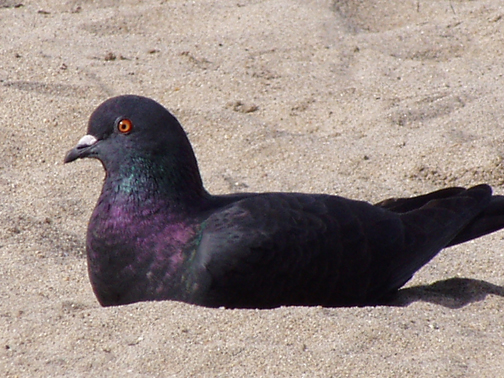
Spread
Wild type pigment (blue/black) plus Spread equals BLACK
You should never call it a "Spread black". It's either Black (as a color) or Spread as the genetic factor that makes it a "black"Note: No tail bar, no wing bars. Also, this is a great shot to see the wild-type eye (orange/red) and a good shot of the nasal cere
Pieds & Splashes
All feral pigeons may or may not show traces or large amounts of white, sometimes in a recognizable pattern (i.e., a pattern recognized by pigeon breeders worldwide) or in no discernible pattern. The amount of white determines what the bird is called. If less than half the bird is white, then breeders usually call it a "pied", if more than half is white then it is called a "splash" (these names are those used by racing homer breeders and some of the show pigeon breeders would use other terminology to describe such birds. However most work on ferals uses the common homer terminology. Occasionally, pure whites also appear, but except on Oahu in Hawaii, they are normally rare in feral populations.
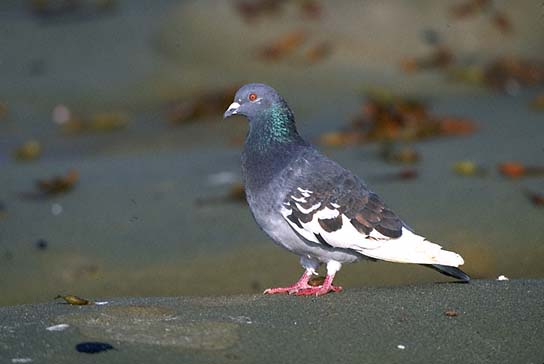
Splash white-flight T-pattern bronze check
(the bronze showing in this bird may be the result of one of the many
known and unknown bronze factors in pigeons.) Based on build and the
general overall gestalt
or "jizz" of this bird, I'd say it was a male or cock bird.
Recommended Reading
Feral Pigeons · by Janiga, Marian, and Johnston, Richard F.
Recommended Links
| Pigeon Genetics Symbols | Recessive Red |
| Frosty Photos | Blue/black pigeons |
| Ember photos (identified in ferals) | Barnhart Loft - More rare colors |
| Rare Colors - click links on page |
BACK TO INDEX